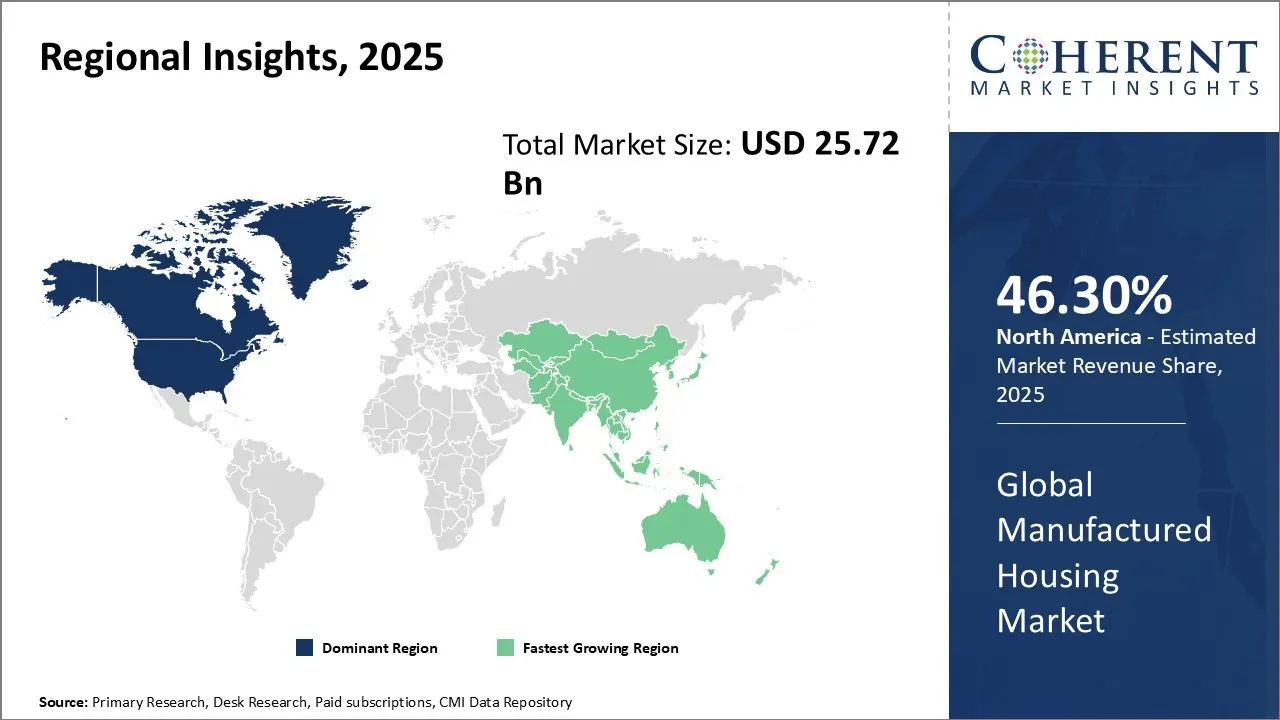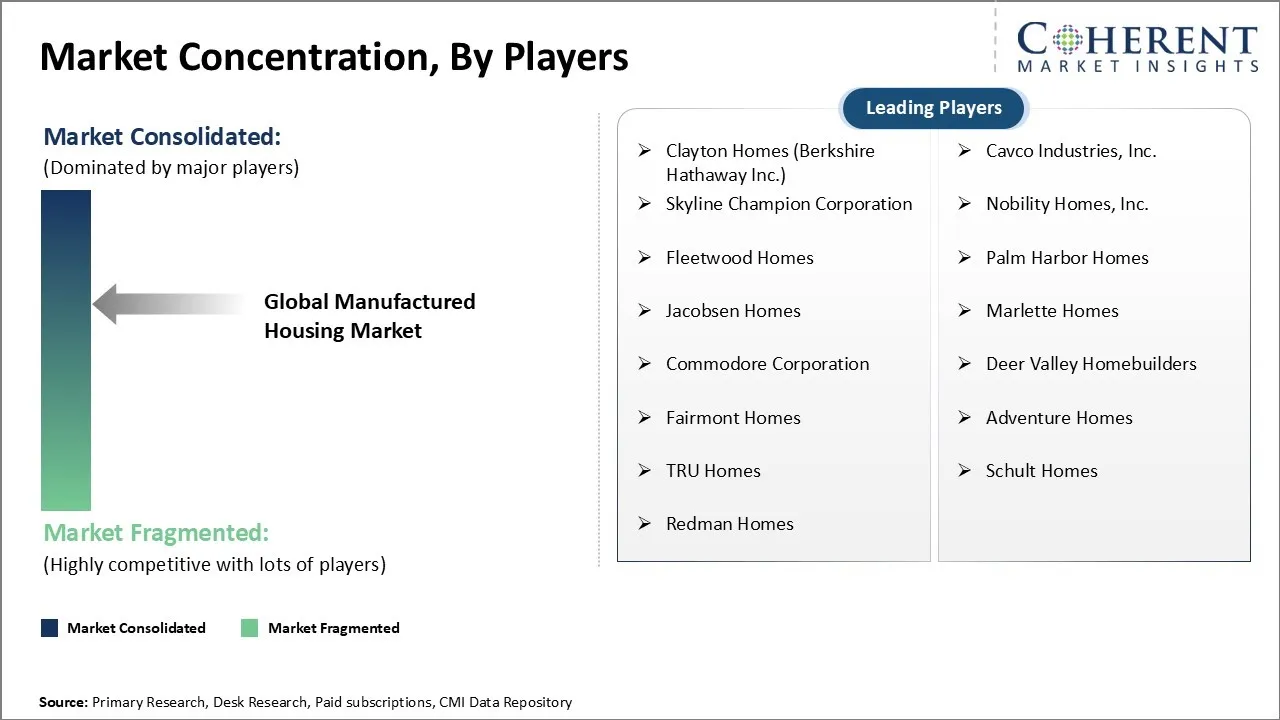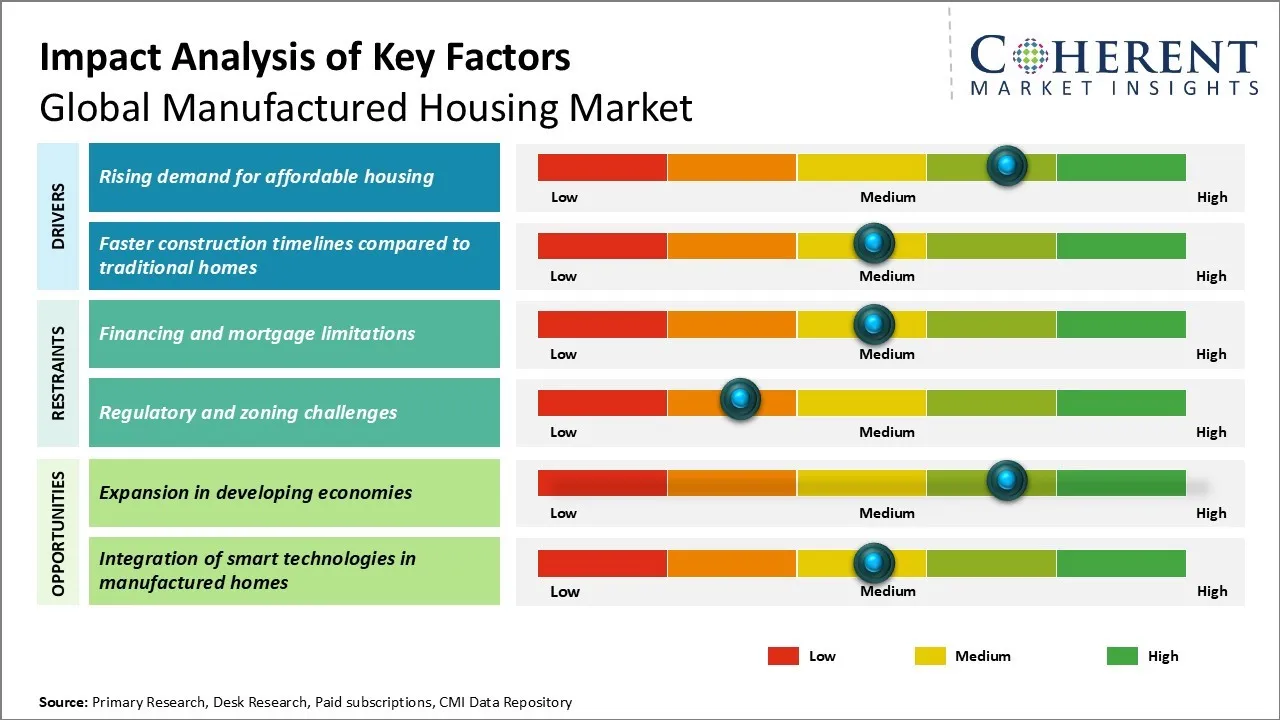Global Manufactured Housing Market Size and Forecast – 2025 - 2032
The Global Manufactured Housing Market is estimated to be valued at USD 25.72 Bn in 2025 and is expected to reach USD 37.17 Bn by 2032, exhibiting a compound annual growth rate (CAGR) of 5.4% from 2025 to 2032.
Key Takeaways of the Global Manufactured Housing Market:
- The multi-section homes segment is expected to lead the market holding a share of 63.6% in 2025.
- The wood segment is projected to dominate with a share of 37.9% in 2025.
- North America is estimated to lead the market with a share of 46.3% in 2025. Asia Pacific, holding a share of 22.7% in 2025, is projected to be the fastest growing region.
Market Overview:
The manufactured housing market is experiencing a significant shift towards more modern, high-quality, and customizable homes. Manufacturers are incorporating advanced technologies and materials to improve the durability, aesthetics, and energy efficiency of their products. Additionally, the increasing adoption of smart home features and the integration of sustainable design elements are expected to further boost the market growth. As more consumers seek flexible and cost-effective housing options, the manufactured housing market is poised for steady expansion in the coming years.
Current Events and their Impact
|
Current Events |
Description and its impact |
|
Regulatory Updates in the U.S. Manufactured Housing Sector |
|
|
Global Economic Pressures |
|
Uncover macros and micros vetted on 75+ parameters: Get instant access to report
Global Manufactured Homes Market Insights, by Type - Multi-section Homes Lead, Being the Preferred Choice for Spacious and Customizable Living
In terms of type, the multi-section homes segment is expected to contribute the highest share of 63.6% in the market in 2025 owing to several key factors that drive its popularity and growth. Multi-section homes, also known as double-wide or triple-wide homes, are more spacious compared to single-section homes. These homes are constructed by joining two or more sections together, resulting in a bigger floor area that can range from 1,000 to over 2,500 square feet.
Also, manufacturers offer a wide variety of floor plans, designs, and features for multi-section homes that allow buyers to personalize their homes to suit their specific needs and preferences. From the number of bedrooms and bathrooms to the layout of the living areas and the choice of finishes and fixtures, multi-section homes provide a high degree of flexibility in terms of design and customization.
Global Manufactured Homes Market Insights, by Material – Wood Leads, Being a Timeless and Eco-Friendly Choice
In terms of material, the wood segment is expected to contribute the highest share of 37.9% in the market in 2025 due to several important factors that drive its continued popularity in the manufactured housing industry. Wood has been a traditional building material for centuries, offering a warm, natural, and inviting look that many homebuyers find attractive. The grain patterns, textures, and colors of wood create a cozy and welcoming atmosphere that can be easily customized to suit various design preferences. Whether it's a rustic cabin-style home or a modern, sleek design, wood can be adapted to fit a wide range of architectural styles.
Wood is also a renewable resource that can be harvested responsibly from well-managed forests, and it has a lower carbon footprint compared to materials like steel or concrete. Additionally, wood is biodegradable and can be easily recycled or repurposed at the end of a home's life cycle, appealing to eco-conscious consumers.
The Role of Artificial Intelligence (AI) in the Market:
AI is reshaping the manufactured housing market by streamlining design, production, and customer engagement. Manufacturers use AI-driven tools for real-time design customization, predictive maintenance, and smart material planning, which significantly reduce construction time and cost. AI also powers virtual sales platforms, enabling buyers to explore home models through interactive tours and get instant assistance via chatbots—enhancing the buying experience.
For instance, Clayton Homes has integrated AI into its design and manufacturing systems to optimize floor plans and automate production scheduling. This has allowed the company to reduce waste, shorten delivery times, and offer customizable, energy-efficient homes at competitive prices. As demand for affordable and sustainable housing grows, AI continues to play a pivotal role in driving innovation and efficiency across the sector.
Regional Insights

To learn more about this report, Download Free Sample
North America Manufactured Housing Market Analysis and Trends
North America, holding a share of 46.3% in 2025, is expected to dominate the manufactured housing market. It has a well-established market ecosystem, and it houses major manufacturers, suppliers, and distributors. The region's advanced infrastructure and logistics network facilitate efficient production and distribution of manufactured homes. Additionally, the increasing demand for cost-effective and flexible housing options, coupled with the rising popularity of prefabricated homes, has further contributed to North America's dominance in the market.
Asia Pacific Manufactured Housing Market Analysis and Trends
The Asia Pacific region, holding a share of 22.7% in 2025, is expected to exhibit the fastest growth in the manufactured housing market. Rapid urbanization, population growth, and increasing disposable incomes in countries like China, India, and Southeast Asian nations have fueled the demand for affordable housing solutions. The presence of large-scale manufacturers and the availability of cost-effective labor and raw materials have further supported the growth of the market in Asia Pacific. Moreover, the region's embrace of innovative construction technologies and the growing preference for sustainable and energy-efficient housing have played a significant role in driving the fastest growth in the manufactured housing sector.
Manufactured Housing Market Outlook for Key Countries:
U.S. Manufactured Housing Market Analysis and Trends
The U.S. manufactured housing market remains robust, driven by the need for affordable housing solutions and the increasing acceptance of prefabricated homes as a viable alternative to traditional site-built housing. Key players such as Clayton Homes, Cavco Industries, and Skyline Champion Corporation have a strong presence in the country, offering a wide range of manufactured housing options. These companies have been investing in research and development to enhance the quality, durability, and energy efficiency of their products.
China Manufactured Housing Market Analysis and Trends
China manufactured housing market has been experiencing significant growth, fueled by the country's rapid urbanization, population growth, and government initiatives to promote affordable housing. The country's large-scale manufacturers, such as Yinhong Modular House and Putian Integrated Housing, have been leveraging advanced manufacturing technologies and efficient production processes to meet the growing demand. These companies have also been focusing on customization and green building practices to cater to evolving consumer preferences. The Chinese government's push for sustainable and eco-friendly housing solutions has further supported the adoption of manufactured homes in the country.
India Manufactured Housing Market Analysis and Trends
India continues to present immense opportunities for the manufactured housing market, driven by the country's vast population, housing deficit, and increasing urbanization. The government's initiatives, such as the "Housing for All" scheme, have created a conducive environment for the growth of the manufactured housing sector.
Companies like Nestudio and Oyster Living have been at the forefront of providing innovative and affordable prefabricated housing solutions in India. These players have been leveraging modern construction techniques, such as modular construction and steel framing, to deliver high-quality homes in shorter timeframes. The market's growth in India is further supported by the increasing acceptance of manufactured homes as a viable housing option among the country's middle-class population.
Japan Manufactured Housing Market Analysis and Trends
Japan manufactured housing market has been characterized by its focus on innovation, quality, and sustainability. The country's aging population and the need for accessible and adaptable housing have driven the demand for manufactured homes.
Companies like Sekisui House and Daiwa House Industry have been leading the way in developing advanced prefabricated housing solutions that prioritize energy efficiency, seismic resistance, and user-friendly features. These players have also been collaborating with international partners to expand their market reach and share expertise.
Market Players, Key Development, and Competitive Intelligence

To learn more about this report, Download Free Sample
Key Developments:
- On May 2, 2025, Clayton, a U.S.-based builder of single-family attainable housing, showcased its innovative portfolio of homes at the annual Berkshire Hathaway Shareholder Meeting in Omaha, Nebraska, (U.S.).
- In April 2025, Family Promise, a U.S.-based non-profit dedicated to addressing family homelessness, extended its partnership with Clayton. Their joint initiative, A Future Begins at Home, focuses on keeping families who are at risk of homelessness in their homes while helping them regain stability.
- In March 2025, Champion Homes, Inc., a mobile and modular home manufacturing company, launched its first national manufactured duplex series, the Concord Duplex Series.
- In January 2025, Mesocore LLC, a U.S.-based modular home manufacturer and one of the few certified container producers in the U.S., combined these concepts to develop a patented building system that efficiently delivers complete, self-sustaining, volumetric modular housing units.
Top Strategies Followed by Global Manufactured Housing Market Players
- Established Players: Leading companies are making research and development (R&D) investments to innovate high-performance products.
- Clayton Homes, one of the largest players in the industry, has heavily invested in R&D to develop CrossMod homes, which combine traditional manufactured housing with site-built aesthetics and quality.
- Mid-Level Players: Mid-level players are adopting strategies centered around delivering cost-effective solutions to attract price-sensitive consumers.
- Nobility Homes, a mid-sized U.S. manufacturer, focuses on affordable, value-oriented manufactured homes, serving mainly Florida through both company-owned and affiliated dealerships. They keep pricing competitive by maintaining control over the entire supply chain.
- Small-Scale Players: Small-scale are targeting specific market segments with unique features or innovative products to carve out a distinct position in the industry.
- Q Prefab specializes in custom-designed modular homes using eco-friendly materials for clients in Northern and Central Europe. Their focus is on energy efficiency, minimal environmental impact, and modern Scandinavian design.
Market Report Scope
Manufactured Housing Market Report Coverage
| Report Coverage | Details | ||
|---|---|---|---|
| Base Year: | 2024 | Market Size in 2025: | USD 25.72 Bn |
| Historical Data for: | 2020 To 2024 | Forecast Period: | 2025 To 2032 |
| Forecast Period 2025 to 2032 CAGR: | 5.4% | 2032 Value Projection: | USD 37.17 Bn |
| Geographies covered: |
|
||
| Segments covered: |
|
||
| Companies covered: |
Clayton Homes (Berkshire Hathaway Inc.), Cavco Industries, Inc., Skyline Champion Corporation, Nobility Homes, Inc., Fleetwood Homes, Palm Harbor Homes, Jacobsen Homes, Marlette Homes, Commodore Corporation, Deer Valley Homebuilders, Fairmont Homes, Adventure Homes, TRU Homes, Schult Homes, and Redman Homes |
||
| Growth Drivers: |
|
||
| Restraints & Challenges: |
|
||
Uncover macros and micros vetted on 75+ parameters: Get instant access to report
Market Dynamics

To learn more about this report, Download Free Sample
Global Manufactured Housing Market Driver - Rising Demand for Affordable Housing
The global manufactured housing market is experiencing a significant driver in the form of rising demand for affordable housing solutions. As populations continue to grow and urbanization expands, many individuals and families are seeking cost-effective alternatives to traditional site-built homes. Manufactured housing offers a compelling option, as these homes are constructed in controlled factory environments, allowing for efficient production and reduced costs compared to conventional construction methods. The affordability of manufactured homes makes them attractive to a wide range of buyers, including first-time homeowners, low-income households, and those looking to downsize.
Freddie Mac and Fannie Mae, government-sponsored enterprises (GSEs) that play a crucial role in the U.S. housing finance system, under the Federal Housing Finance Agency’s Duty to Serve initiative, have expanded loan programs for manufactured homes to enhance access to credit for low- and moderate-income families.
Global Manufactured Housing Market Opportunity - Expansion in Developing Economies
The global manufactured housing market has a significant opportunity for growth and expansion in developing economies. As these countries experience rapid urbanization, population growth, and rising housing demands, manufactured homes present a viable and cost-effective solution. Developing economies often face housing shortages, particularly in urban areas, and the quick construction timelines and affordability of manufactured homes can help bridge this gap.
India is increasingly turning to manufactured and modular housing to meet the demands of its urbanizing population. Under initiatives like the Pradhan Mantri Awas Yojana (PMAY), the government has promoted affordable housing through faster and scalable construction methods. Additionally, India-based construction firms such as Bharat Nirman and Tata Housing are partnering with prefab solution providers to deliver mass housing units in states like Maharashtra, Uttar Pradesh, and Tamil Nadu.
Analyst Opinion (Expert Opinion):
- Rising geopolitical tensions—especially between major economies like the U.S. and China or within Eastern Europe—have disrupted global supply chains for key construction materials such as steel, timber, and insulation. Manufactured housing, heavily reliant on prefabricated components and cross-border logistics, faces increased raw material costs and delivery delays.
- As nations push for housing independence and resilience in construction ecosystems, governments and private players are increasingly investing in localized or near-shore manufactured housing facilities.
- For instance, North America and Southeast Asia are witnessing a rise in modular construction parks to reduce reliance on foreign imports. This shift could re-balance global market dynamics and create new regional leaders in prefab housing production.
Market Segmentation
- Type Insights (Revenue, USD Bn, 2020 - 2032)
-
- Multi-section Homes
- Single-section Homes
- Material Insights (Revenue, USD Bn, 2020 - 2032)
-
- Wood
- Steel
- Composite Materials
- Others
- Regional Insights (Revenue, USD Bn, 2020 - 2032)
-
- North America
- U.S.
- Canada
- Latin America
- Brazil
- Argentina
- Mexico
- Rest of Latin America
- Europe
- Germany
- U.K.
- Spain
- France
- Italy
- Russia
- Rest of Europe
- Asia Pacific
- China
- India
- Japan
- Australia
- South Korea
- ASEAN
- Rest of Asia Pacific
- Middle East
- GCC Countries
- Israel
- Rest of Middle East
- Africa
- South Africa
- North Africa
- Central Africa
- North America
- Key Players Insights
- Clayton Homes (Berkshire Hathaway Inc.)
- Cavco Industries, Inc.
- Skyline Champion Corporation
- Nobility Homes, Inc.
- Fleetwood Homes
- Palm Harbor Homes
- Jacobsen Homes
- Marlette Homes
- Commodore Corporation
- Deer Valley Homebuilders
- Fairmont Homes
- Adventure Homes
- TRU Homes
- Schult Homes
- Redman Homes
Sources
Primary Research Interviews:
Stakeholders:
- Modular and Manufactured Housing Builders (e.g., Plant Managers, Assembly Line Supervisors)
- Prefabricated Housing Component Suppliers (e.g., Roofing, HVAC, and Insulation vendors)
- Real Estate Developers and Affordable Housing Project Managers
- Government Housing Officials (Urban Development & Smart Cities divisions)
- Financial Institutions offering housing loans or financing for modular units
- Sustainability and Off-Grid Living Consultants
Databases:
- Eurostat
- U.S. Census
- OECD
Magazines:
- Housing Industry Today
- Offsite Construction News
- Prefab Living Magazine
- Modular Housing Trends
Journals:
- Journal of Modular Construction and Housing
- International Journal of Housing Markets and Analysis
- Housing Studies Journal
- Journal of Sustainable Urban Development
Newspapers:
- The Construction Index
- Construction Week Online
- The Guardian (UK)
- The Economic Times (India)
Associations:
- Modular Building Institute (MBI)
- National Association of Home Builders (NAHB)
- Prefabricated Housing Association (Global)
- Offsite Construction Council (USA)
- International Federation for Housing and Planning (IFHP)
Public Domain Sources:
- U.S. Census Bureau
- EUROSTAT
- United Nations Economic Commission for Europe (UNECE)
- World Bank
- ResearchGate
Proprietary Elements:
- CMI Data Analytics Tool, Proprietary CMI Existing Repository of information for last 8 years
Share
Share
About Author
Ramprasad Bhute is a Senior Research Consultant with over 6 years of experience in market research and business consulting. He manages consulting and market research projects centered on go-to-market strategy, opportunity analysis, competitive landscape, and market size estimation and forecasting. He also advises clients on identifying and targeting absolute opportunities to penetrate untapped markets.
Missing comfort of reading report in your local language? Find your preferred language :
Transform your Strategy with Exclusive Trending Reports :
Frequently Asked Questions
EXISTING CLIENTELE
Joining thousands of companies around the world committed to making the Excellent Business Solutions.
View All Our Clients


